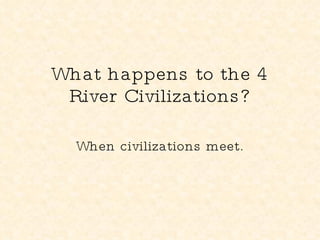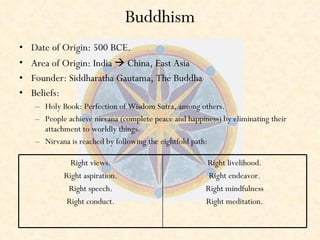What Happened To The 4 River Civilizations
- 1. What happens to the 4 River Civilizations? When civilizations meet.
- 2. Indo-Europeans Migrate Groups of nomadic people from the Caucus Mtn. steppes driven from Mesopotamia and Indus Valley. Settle in Eastern and Western Europe, India. Why? We don’t know.
- 3. Mesopotamia and Egypt Hittites: 2000 BCE: Occupy Anatolia (Turkey). 1650 BCE: Hattusas. Occupy Babylon, struggle with the Egyptians. Culture: Borrow. Technology: Chariots – iron ore and lumber 1190 BCE: Fall.
- 4. Mesopotamia Minoans: 2000 -1400 BCE. Lived on Crete, seafaring. Facilitate trade (between Asia Minor [Turkey], Europe, and the Middle East). 1470 BCE: Earthquake
- 5. Mesopotamia Phoenicians: 1100 BCE: Take over from the Minoans. Superior traders, merchant vessels. Connect Africa, Europe, and Asia.
- 6. Indus Valley Aryans: 2000 BCE: Settle in the Northwest Indus Valley. Vedas – sacred literature. Caste System: Brahmins, warriors, landowners, peasants or traders. Varna. 1000 BCE: Arrive in India; Magadha. 2 BCE: Magadha is modern India.
- 7. China Nothing! Why? Geography. Stable political, social, and economic landscape. Shang ïƒ Zhou lasts until 256 BCE.
- 8. The Birth of World Religions A metaphor for when civilizations meet.
- 9. Proof Given: World religions resulted from more sophisticated civilization, trade, and intermingling of the 4 River Civilizations. If: Religious beliefs are non-material culture. Religious icons and edifices are material culture. Religious texts are primary sources. Then: World religions can tell us the political, economic, and cultural events, individuals, and ideas from their historical time period.
- 10. Hinduism Date of Origin:1200 – 700 BCE. Area of Origin: India/Aryan Invasion Founders: Multiple founders. Beliefs: Holy Book: Vedas, Puranas, among others. Reincarnation. Enlightenment is achieved if you are free from earthly desires. Freedom from earthly desires comes from a lifetime of worship, knowledge, and virtuous acts.
- 11. Hinduism 1600 – 1000 BCE: Aryan invasions. 1500 – 1000 BCE: Vedic Age: Political: Expand to the Ganges Valley. Cultural: Sanskrit. Vedas. 1028: Rig-Veda.
- 12. Hinduism 1000 – 600 BCE: Epic Age: Poltical: Village organization: Chiefs ïƒ patriarch ïƒ children. Villages responsible for defense and regulation. Caste system? Cultural: Mahabrata, Ramanya, and the Upanishads. Caste system (varnas): Aryans vs. indigenous? Economic: Caste system
- 13. Judaism Date of Origin: 1200 BCE. Area of Origin: Mediterranean, Israel. Founders: Abraham. Beliefs: Holy Book: The Torah. One god. People are accountable for their sins. People serve god by studying the Torah and living by its teaching.
- 14. Judaism 1200 BCE: The Jews settle in Israel. Lose and regain independence several times: Abraham – Canaan. Egypt. Moses and Exodus. 63 BCE: Romans seize the state outright.
- 15. Buddhism Date of Origin: 500 BCE. Area of Origin: India ïƒ China, East Asia Founder: Siddharatha Gautama, The Buddha Beliefs: Holy Book: Perfection of Wisdom Sutra, among others. People achieve nirvana (complete peace and happiness) by eliminating their attachment to worldly things. Nirvana is reached by following the eightfold path: Right livelihood. Right endeavor. Right mindfulness Right meditation. Right views. Right aspiration. Right speech. Right conduct.
- 16. Buddhism 563 BCE: Indian prince named Siddartha Gautama born. Brahman opposition. Hinduism adapts with mysticism. Spread to southeast Asia, Sri Lanka. Indian pockets.



![Mesopotamia Minoans: 2000 -1400 BCE. Lived on Crete, seafaring. Facilitate trade (between Asia Minor [Turkey], Europe, and the Middle East). 1470 BCE: Earthquake](https://image.slidesharecdn.com/whathappenedtothe4rivercivilizations-100916162430-phpapp01/85/What-Happened-To-The-4-River-Civilizations-4-320.jpg)











